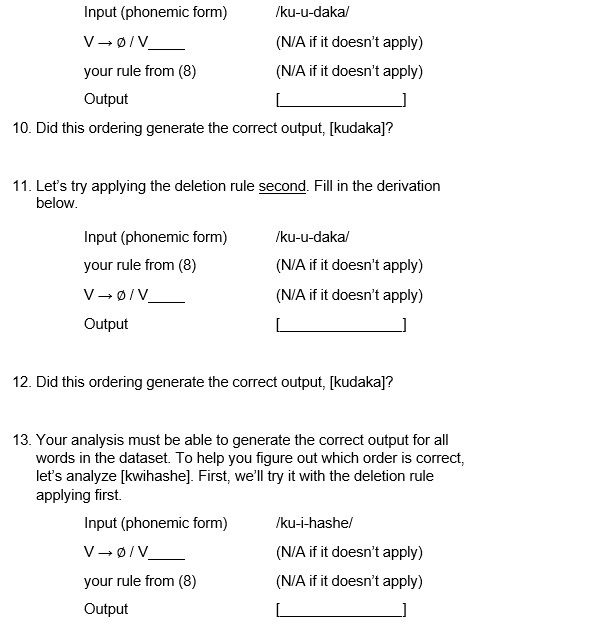Phonology Assignment
- Country :
Australia
More phonology
The data below is from Xhosa, a Bantu language of southern Africa. In the leftmost column (nominative forms), youll find a prefix that marks noun class and a root. The morpheme boundary has already been marked. In the center column (partitive forms), youll find two prefixes and a root. These forms include the partitive prefix, as well as the same class-marking prefix you see in the nominative forms. Thus, the nominative forms have two morphemes while the partitive have three morphemes (partitive + class-marking prefix + root).
|
Nominative |
Partitive |
Gloss |
|
u-daka |
kudaka |
mud |
|
u-buso |
kubuso |
face |
|
u-kutja |
kukutja |
food |
|
i-hashe |
kwihashe |
horse |
|
i-?kosi |
kwi?kosi |
chief |
|
i-zitja |
kwizitja |
basket |
|
a-bantu |
kubantu |
Bantu |
|
a-madoda |
kumadoda |
men |
1. Two rules are needed to describe these data. The first is a rule of vowel deletion:

2. Identify each part of the rule above.
- Translate this rule into normal English.
- What is the target of the rule?
- What is the change the rule makes?
- What is the context?
3. If the word, [kumadoda] is composed of three morphemes, a prefix /ku/, another prefix, /a/, and the root, /madoda/, provide a derivation for this word, using the rule from above.

4. The partitive prefix is produced two different ways in the data above. One is [ku]; identify the other.
[ku]
[kw]
[ki]
[kua]
5. What is the phonetic difference between second sound in [ku] ([u]!) and the second sound in the form you just selected in (4)? To say this differently, if you start with /u/ and turn it into the second sound of your answer for (4), what change did you make? Re-reading Section 5 of the phonetics chapter will help you.
6. For the words that have the other variant of the partitive prefix, the one that is not [ku], look at the nominative forms (leftmost column). What is unique about the prefix in those forms (the single vowel to the left of the hyphen), compared to the other words in that leftmost column?
A. the prefix for those words in the leftmost column is [i]
B. the corresponding words in the leftmost column dont have a prefixC. the prefix for those words in the leftmost column is [a]
D. the prefix for those words in the leftmost column is [u]
7. If we drew a diagram representing the variation in the partitive prefix, it would look something like this:



15. Which rule ordering in (13) and (14) generated the correct output, [kwihashe]? In other words, tell me which rule should apply first and which should apply second.
16. Based on your analysis, how should the following input (phonemic form) be pronounced by a Xhosa speaker, /ku-a-taku/?

